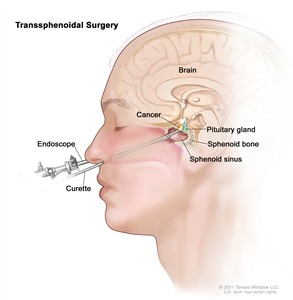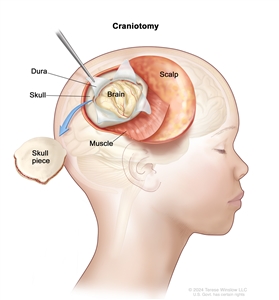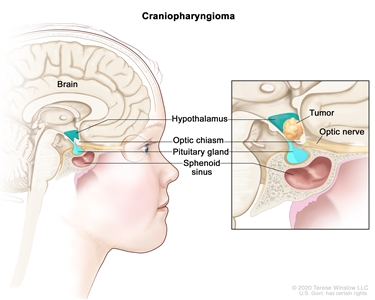Types of treatment for childhood craniopharyngioma
Who treats children with craniopharyngioma?
A pediatric oncologist, a doctor who specializes in treating children with cancer, oversees treatment for childhood craniopharyngioma. The pediatric oncologist works with other health care providers who are experts in treating children with brain tumors and who specialize in certain areas of medicine. Other specialists may include:
- pediatrician
- neurosurgeon
- radiation oncologist
- neurologist
- endocrinologist
- ophthalmologist
- rehabilitation specialist
- psychologist
- social worker
- nurse specialist
There are different types of treatment for children and adolescents with craniopharyngioma. Although craniopharyngioma is not cancer, treatment is often similar to cancer treatment and may include surgery, radiation therapy, and other approaches. You and your child's care team will work together to decide treatment. Many factors will be considered, such as your child's age and overall health, where the tumor is located and whether it has spread into nearby tissue, and the possible side effects and late effects of treatment.
Your child's treatment plan will include information about the tumor, the goals of treatment, treatment options, and the possible side effects. It will be helpful to talk with your child's care team before treatment begins about what to expect. For help every step of the way, visit our booklet, Children with Cancer: A Guide for Parents.
Types of treatment your child might have include:
Surgery
The type of surgery your child will have depends on the size of the tumor, where it is in the brain, and whether it has grown into nearby tissue in a finger-like way. It also depends on expected late effects that may occur after surgery.
The types of surgery that may be used to remove the tumor that can be seen with the eye include:
- Transsphenoidal surgery is a type of surgery in which a surgeon inserts instruments into the brain by going through a cut made under the upper lip or at the bottom of the nose between the nostrils. Then they go through the sphenoid bone (a butterfly-shaped bone at the base of the skull) to reach the tumor near the pituitary gland and hypothalamus.

Transsphenoidal surgery. An endoscope and a curette are inserted through the nose and sphenoid sinus to remove the tumor.
- A craniotomy is surgery to remove the tumor through an opening made in the skull.

Craniotomy. An opening is made in the skull and a piece of the skull is removed to show part of the brain.
To help make a diagnosis, sometimes the surgeon will remove only part of the tumor. If a tumor is near the pituitary gland or hypothalamus, it will not be removed. Leaving the tumor helps reduce serious side effects from the surgery.
Sometimes, the surgeon will remove all of the tumor that they can see and no further treatment is needed. At other times, they may not be able to remove the tumor because it is growing into or pressing on nearby organs.
Surgery for cysts
If your child's tumor is mostly a fluid-filled cyst, they may have surgery to drain it. Draining it lowers the pressure in the brain and relieves symptoms.
A surgery called a partial resection can be used to remove fluid from cystic craniopharyngiomas. Or a thin tube called a catheter can be inserted into the cyst, and a small container placed under the skin. The fluid drains into the container and is later removed.
Sometimes, after the cyst is drained, a drug is put through the catheter into the cyst. This causes the inside wall of the cyst to scar and stops the cyst from making fluid. Or it can slow down how long it takes for the fluid to build up again. Surgery to remove the tumor or radiation therapy may be done after the cyst is drained.
Radiation therapy
Radiation therapy uses high-energy x-rays or other types of radiation to kill tumor cells or keep them from growing. It is often given after surgery to kill any tumor that is left in the brain.
Both external radiation therapy and internal radiation therapy (also called brachytherapy) are used to treat craniopharyngiomas.
- External radiation therapy uses a machine outside the body to send radiation toward the area of the body with the tumor.
- Internal radiation therapy uses a radioactive substance sealed in needles, seeds, wires, or catheters that are placed directly into or near the tumor.
Radiation therapy to the brain can affect growth and development in young children, so ways of giving radiation therapy that have fewer side effects are often used. These include:
- Stereotactic radiosurgery may be used for very small craniopharyngiomas at the base of the brain. For this treatment, a rigid head frame is attached to the skull to keep the head still during the treatment. Then, a machine aims a single large dose of radiation directly at the tumor. This procedure is a type of radiation therapy and does not involve surgery. It is also called stereotaxic radiosurgery, radiosurgery, and radiation surgery.
- Intracavitary radiation therapy is a type of internal radiation therapy that may be used in tumors that are part solid mass and part fluid-filled cyst. For this treatment, radioactive material is placed inside the tumor. This type of radiation therapy causes less damage to the nearby hypothalamus and optic nerves.
- Intensity-modulated photon therapy is a type of radiation therapy that uses x-rays or gamma rays that come from a special machine called a linear accelerator (linac) to kill tumor cells. A computer is used to target the exact shape and location of the tumor. Then thin beams of photons of different strengths are aimed at the tumor from many angles. This type of 3-dimensional radiation therapy may cause less damage to healthy tissue in the brain and other parts of the body.
- Proton-beam radiation therapy is a type of radiation therapy that uses streams of protons (tiny particles with a positive charge) to kill tumor cells. This treatment can reduce the amount of radiation damage to healthy tissue near a tumor.
Learn more about Radiation Therapy to Treat Cancer.
Chemotherapy
Chemotherapy (also called chemo) uses drugs to stop the growth of tumor cells. Chemotherapy either kills the tumor cells or stops them from dividing.
Chemotherapy can be placed directly into a cavity, such as a cyst. This way of giving chemotherapy is intracavitary chemotherapy. Bleomycin is a type of chemotherapy that can be placed directly into a cystic craniopharyngioma.
Learn more about Chemotherapy to Treat Cancer.
Observation
Observation means that your child's condition is closely watched without receiving treatment until symptoms appear or change.
Clinical trials
For some children, joining a clinical trial may be an option. There are different types of clinical trials for childhood cancer. For example, a treatment trial tests new treatments or new ways of using current treatments. Supportive care and palliative care trials look at ways to improve quality of life, especially for those who have side effects from cancer and its treatment.
You can use the clinical trial search to find NCI-supported cancer clinical trials accepting participants. The search allows you to filter trials based on the type of cancer, your child's age, and where the trials are being done. Clinical trials supported by other organizations can be found on the ClinicalTrials.gov website.
Learn more about clinical trials, including how to find and join one, at Clinical Trials Information for Patients and Caregivers.
Treatment of newly diagnosed childhood craniopharyngioma
Treatment of newly diagnosed childhood craniopharyngioma may include:
- complete removal of the tumor with surgery with or without radiation therapy
- partial removal of the tumor with surgery followed by radiation therapy
- cyst drainage, followed by observation, radiation therapy, or surgery
- brachytherapy or chemotherapy placed directly in the cyst or tumor
Use our clinical trial search to find NCI-supported cancer clinical trials that are accepting patients. You can search for trials based on the type of cancer, the age of the patient, and where the trials are being done. General information about clinical trials is also available.
Treatment of progressive or recurrent childhood craniopharyngioma
Treatment options for progressive or recurrent childhood craniopharyngioma depend on the type of treatment that your child received when the tumor was first diagnosed and your child's needs.
Treatment may include:
- surgery
- external-beam radiation therapy
- brachytherapy or intracavitary chemotherapy
- observation
Use our clinical trial search to find NCI-supported cancer clinical trials that are accepting patients. You can search for trials based on the type of cancer, the age of the patient, and where the trials are being done. General information about clinical trials is also available.


